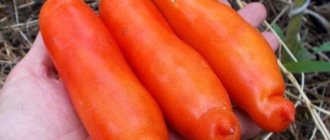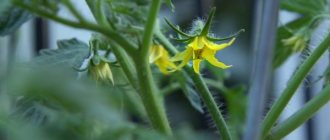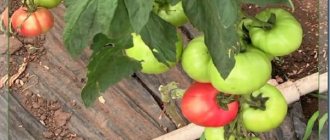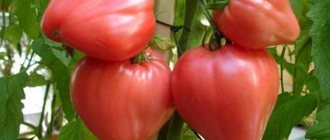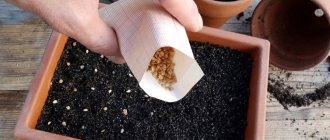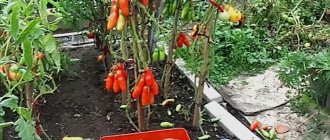Tomatoes Evpator F1: variety description
Tomato Evpator belongs to the indeterminate type,
therefore, its shoots are unlimited in growth. The variety is mid-season in terms of fruit ripening - about 3.5 months pass from germination of planting material to harvesting ripe tomatoes.
Photo of tomato Evpator F1
The bushes are tall, not spreading, the height of the shoots is up to 1.8-2.0 m. The stems should be tied to supports, the stepsons should be removed, and the bushes should be formed. Usually this tomato is formed into 1 or 2 stems. A stepson is left under the second stem, which forms under the first inflorescence. All other stepsons must be removed as they appear.
The stems are medium leafy, the foliage is of a typical tomato shape, medium in size, rich emerald color, elongated with small sharp tips.
The flowers are small in size, yellow in color, collected in racemes. Each inflorescence can form up to 5-7 ovaries. Pollination of flowers occurs naturally, therefore, in greenhouses, windows and doors should always be open during the flowering period so that there is a slight draft.
Tomato Evpator F1 - video
Main characteristics
The first brush is formed after the 9th permanent leaf, each subsequent one - after 3 leaflets.
Ripe Evpator tomatoes are medium in size, round, slightly elongated, even, compact, with smooth, glossy, dense skin. The color of the skin and pulp is red. The skin is not prone to cracking. Fruit weight – 120-130 g.
Photos of unripe tomatoes Evpator
On a note!
The taste of ripe tomatoes of the Evpator variety is sweetish, with a characteristic sourness.
The pulp is slightly compacted, juicy, there are up to 4 seed chambers inside, there are few seeds. But since this is a hybrid, the seeds cannot be used for further planting, because the resulting plants will not have the parental characteristics.
EXCELLENT VARIETIES OF TOMATOES!
Tomato Olya F1 Tomato Batyanya BIF tomato Nina
The harvested crop perfectly tolerates transportation over any distance, does not crack or leak.
Tomatoes are well stored for a long time, so this tomato variety is good to grow for further sale of ripe products.
The collected fruits are of universal use; they can be used for preparing salads and snacks, as well as canned. Tomatoes do not crack during heat treatment, so Evpator’s pickled tomatoes are distinguished by their beautiful appearance and excellent taste.
Tomato Evpator. Varieties and hybrids that you liked - video
Productivity of the tomato variety Evpator
At least 40 kg of ripe produce is usually collected from each square of area, and up to 5-6 kg from each bush.
For the first time, ripe fruits can be collected within 3.5 months after germination of the seed material. When planting Evpator tomato seeds in February in greenhouse conditions, the harvest is harvested at the end of May - beginning of June, but the bushes of this tomato continue to bear fruit in closed ground until November.
But good yield of this hybrid is observed only in greenhouses, where the growing conditions are most comfortable for them; in open ground, no more than 2.5-3 kg per bush is collected.
Tomato Evpator. Tasting - video
Diseases and pests
This hybrid variety is resistant to many diseases:
- cladosporiosis;
- fusarium;
- viral mosaic;
- top rot.
When growing this hybrid in greenhouse conditions, it is necessary to monitor soil and air humidity, otherwise tomato bushes may be affected by fungal diseases, as well as Phoma or dry spotting.
The main pests that the Evpator tomato is afraid of are whitefly and cutworm.
Advantages and disadvantages
The main advantages of the Evpator variety include:
- high productivity;
- fruits are approximately the same size and shape;
- fruit ripening is uniform and almost simultaneous;
- high resistance to most diseases;
- the variety can be grown for further sale of fruits, since the safety of the harvest is approximately 85%;
- since this hybrid is a greenhouse hybrid, it can be grown even in the northern regions - in heated greenhouses.
The negative qualities of the Evpator hybrid are:
- bushes should be constantly pinched and tied up;
- To obtain high yields, tomatoes should be grown in greenhouses; in open ground, the fruiting of the Evpator hybrid is too low.
Origin
Evpator tomatoes are classified as hybrid varieties - their characteristics are not inherited. The variety was obtained at the beginning of the 21st century. Russian breeders, the Gavrish company took part in this. Entry into the State Register occurred in 2002.
The variety was included in the third light zone, which means that it grows well in the northern regions. It is preferable to plant it in greenhouses and greenhouses - in a low-volume crop in an extended rotation.
One of the main characteristics of the Evpator tomato bush is that it belongs to indeterminate varieties. Their height is not limited to certain limits, so gardeners take measures to slow growth. At the same time, plants of the Evpator variety, according to the description, are classified as standard, i.e., low-growing. On average they reach 1.8 m in height. There are often many branches on bushes.
The inflorescences are simple. The first appears above the 9th sheet, the rest usually with an interval of 3 sheets. One inflorescence brings 7-8 vegetables.
Tomato Evpator F1: stages of planting, growing seedlings and transplanting into open ground, greenhouse
This variety should be grown by seedlings, and the seed material should be planted approximately 1.5 months before the intended transplantation into greenhouse conditions.
In the Moscow region and regions with similar climatic conditions, seeds should be sown in the second ten days of March, and in the southern regions - in the second ten days of February.
Sowing seed material
Soil for sowing Evpator tomato seeds can be purchased in specialized stores, purchasing special soil for growing vegetable seedlings. But you can prepare it at home by mixing garden soil, humus and peat in equal proportions, and you can also add wood ash and mineral additives to it.
Photo of planting tomato seeds
On a note!
But before laying out the soil prepared at home, it should be disinfected - keep it in a heated oven or spill it with a weak solution of potassium permanganate.
Containers for growing Evpator tomato seedlings should be shallow, but long and wide. They should also be disinfected before using for growing tomatoes.
INTERESTING TO KNOW!
Varieties of black tomatoes
Seeds are buried 10 mm into the soil, the distance between them should be about 2 cm, and between adjacent rows - 3 cm.
After planting and spraying the soil with a spray bottle, the containers are covered with polyethylene and placed in a warm room until germination.
Landing
Sowing of seed material is carried out one and a half months before planting in a permanent place of growth. This nightshade variety requires a light, nutritious soil mixture. Before planting, it is recommended to treat the soil with a weakly concentrated solution of potassium permanganate. Using this procedure, you can provide protection against pest larvae and fungal spores. Before planting in a box, the soil should warm up to room temperature.
The landing algorithm is as follows:
- make grooves in the soil, their depth should be about 1 centimeter;
- place the seeds in the groove, the intervals between them should be at least two centimeters;
- cover the box with cling film and move it to a warm room;
- when sprouts appear, the film must be removed;
- when the first pair of true leaves appears, a picking procedure is carried out, the sprouts need to be transplanted into separate pots;
- Fertilizing is carried out once, for this purpose a complex fertilizer is used.
Growing seedlings
Before transplanting seedlings into a greenhouse, they need to be hardened off. To do this, place it in a cool room for several hours a day. To prevent plants from being infected by fungal spores or pest larvae, seedlings should not be planted in the area where other types of nightshades were previously grown - potatoes, peppers.
You need to regularly moisten the soil with warm, settled water. In this case, you need to ensure that water does not stagnate in the top layer of soil, otherwise bacterial rot may develop. To avoid stretching the sprouts, the box with seedlings is periodically turned with the other side towards the sun.
Landing in the ground
The seedlings are transplanted into the greenhouse in the first ten days of June.
The landing algorithm is as follows:
- dig up the selected plot of land;
- dig holes, add fertilizer;
- place the root of the seedling in the hole and sprinkle with soil;
- plant seedlings in rows, maintaining intervals between each bush of at least 30 centimeters;
- moisten the soil substrate;
- install supports for tall bushes.
Further care of seedlings
After the shoots emerge, the film is removed and the boxes are moved to a bright place. For a week and a half, the room temperature is reduced by 6-8 degrees Celsius to harden the sprouts. Then the temperature is raised again to 22-24 degrees.
Seedlings should be watered regularly when the top layer of soil dries out. The main thing is to prevent moisture from stagnating in the containers. While growing seedlings, they should be fed at least once with fertilizer containing potassium salt. This feeding strengthens the roots of the seedlings and will allow the plants to acclimatize better and faster in a new place.
USEFUL ARTICLE:
Why leaves of tomatoes in a greenhouse dry out and turn yellow
After several permanent leaves have appeared on young tomatoes, the seedlings are planted in separate containers so that the grown tomatoes have more room to grow.
A couple of weeks before planting seedlings in greenhouses, they should be hardened off by taking them into the greenhouse for a short time and gradually increasing the time the plants stay in conditions close to those for further cultivation.
Features of fruiting
The first tomatoes are obtained 110 days after emergence. From one bush you can get up to 6 kg of tomatoes.
The taste is slightly sour. Good for preservation. Their small size allows them to be salted as a whole. They do not crack when poured with hot water. They tolerate transportation well. They are stored for a long time. Excellent for growing on farms.
It produces a large harvest only if the rules of agricultural technology are followed correctly.
Tomato Evpator gives a large harvest only if agricultural conditions are met
Transplanting seedlings into a greenhouse
When transplanting seedlings, you need to take into account that the bushes grow large, so no more than three tomato bushes of a given variety should be planted on one square of area. If the Evpator tomato is formed into 1 stem, then 4 bushes can be planted per 1 m2.
Photo of planting seedlings in a greenhouse
The distance between seedlings in a row should be at least 0.4 m, and the row spacing should be 0.6 m. A layer of complex fertilizers that do not contain nitrogen is poured into the prepared holes at the bottom and 5 liters of water are poured.
Each plant is placed in a hole and covered with soil. The height of the seedlings should be at least 15 cm, and the age should be about 1.5 months.
Growing
Seeds need to be sown 45 days before planting in the ground. Residents of the middle zone do this in mid-March, and southerners - at the end of February.
Sowing seeds
Sowing must take place according to a certain algorithm, which will help to do everything correctly.
- We prepare light fertile soil. The soil should be treated against possible infections in any available way: calcined, steamed, spilled with potassium permanganate at the rate of 1 tsp. for 1 liter of water.
- At a distance of 2-3 cm from each other, we sow the seeds 1 cm deep.
- Maintain a distance of 3 cm between grooves.
- We moisten the soil using a sprayer to avoid clogging the soil and the formation of a crust on its surface.
- Cover the container with film or glass.
- We place it with the sown seeds in a warm place.
Transplanting seedlings into the ground
After 45 days, if beautiful and healthy seedlings have grown (at least 15 cm long), it’s time to replant them.
The variety is large: 2-3 bushes are planted per m².
There is one trick: you can plant 4 bushes, 2 in one hole, with the condition of its further formation into 1 stem.
Basic landing rules
Planting a crop consists of several steps.
- The distance between rows is 60 cm.
- The distance between bushes is 40 cm.
- Water the holes, first add natural fertilizer (ash, humus, chicken droppings) to the water.
- Plant the plants and cover the roots with soil, compacting it a little with your hands.
When planting, the seedlings are slightly buried, which allows an additional number of roots to form on the stem.
Further care for Evpator tomatoes
Although this hybrid is quite unpretentious and does not require special care, certain rules must still be followed when growing the Evpator tomato.
Stepsoning
A large number of stepsons are constantly formed on the bushes of this variety, which must be constantly removed so that they do not take away a large amount of nutrients necessary for the formation of ovaries and ripening of fruits.
Photo of pinching tomatoes
It is also necessary to form Evpator tomato bushes for better yield. Usually one or two stems are left on such tomatoes, and after the formation of 6 inflorescences on the central stem, the tops are pinched.
Irrigation regime
It is best to install a drip mode in greenhouses, in which case the soil in the greenhouse will not dry out, but there will be no excess moisture in the soil. With normal watering, you need to add water to the beds once every 3-4 days.
Weeding and loosening
After watering, it is necessary to loosen the root zone of the tomato bushes, simultaneously removing all weeds, and then add a layer of mulch.
Tomato bushes also need to be tied to a strong support, since their shoots are tall and produce a large number of fruits at the same time. To prevent the stems from breaking off, gartering of the shoots is necessary.
Feeding tomatoes Evpator
In order for the yield of these tall plants to be high, it is necessary to constantly fertilize. For the first time, fertilizers are applied to the soil 1.5 weeks after transplanting the Evpator tomato seedlings into the greenhouse. Mineral fertilizers with low nitrogen content are used as fertilizing. You can dilute nitrogen nitrate in the following proportion:
for 10 liters of water you need to take 25 g of the drug, and 0.7 liters of working solution are added to each plant.
After 1.5 weeks, the plants can be fed with bird droppings diluted with water in a ratio of 1:20.
You also need to fertilize during the period of flowering and ovary formation. The amount of fertilizer is doubled.
In the last ten days of August, the resulting flowers are torn off - the tomatoes will no longer ripen on them.
How to grow?
To obtain a rich harvest, you should know some of the subtleties of the growing process and follow all the recommendations of the breeders who bred this variety. Seeds are planted in March - early April, depending on weather conditions. After 45 days, the seedlings are already transplanted into closed ground. It should be light and at room temperature. To provide the soil with lightness and a loose structure, you should mix equal parts of plain soil, turf soil, peat and humus.
It is recommended to keep the prepared soil for 1-2 weeks in a warm place for uniform heating. Before planting, you should treat it with a weak solution of potassium permanganate, pour boiling water over it or bake it in the oven. This will prevent pests from appearing. There is no need to additionally treat the seeds before planting.
Planting seeds
Prepared soil is poured into a box about 12 cm high. The seeds are placed in grooves made in advance, having a depth of 1 cm. A gap of 2-3 cm should be maintained between the seeds. The grooves must be sprinkled with earth. The gap between them should be about 3-4 cm. After planting, the box should be covered with film or glass and placed in a warm room. It is recommended to maintain a temperature of about 23 degrees.
Picking (transplanting into separate cups or pots) is carried out after two true leaves appear on the stems. At the same time, weak, sickly seedlings can be thrown away immediately; they will not produce a large harvest. The volume of the pots should be 200-400 g. This is quite enough for the root system of the crop.
Before transplanting plants into the greenhouse, young plants must be hardened off. To do this, they should be transferred to a greenhouse for a short time.
Planting in a greenhouse
It should be noted that it is not recommended to plant tomatoes in the same area where other crops from the nightshade family previously grew. This may contribute to the development of diseases. The seedlings should be transplanted into the greenhouse when the frosts have passed. Usually this is the end of May or the beginning of June. The optimal temperature for normal growth and ripening of fruits is 24–28 degrees.
The soil in the greenhouse must be dug up to a depth of about 20-30 cm. Plants should be planted at a distance of 25 cm from each other in moist soil. You need to leave 60 cm between the rows. Seedlings are planted in the dug holes and sprinkled with earth.
Care
Feeding is a mandatory procedure. 10 days after transplanting into the greenhouse, the plants can be fed with complex fertilizers or ammonium nitrate. The solution is prepared simply: 1 tablespoon of the drug is diluted in a bucket of water at room temperature. 700-1000 ml of the resulting solution is poured under the bush. The next feeding is carried out 10-12 days after the first. Tomatoes should be fed only on moist soil, so as not to injure the root system of the plant.
Watering should be done as needed. Watering should be plentiful, but care must be taken to ensure that the soil does not become waterlogged. Warm water is used for irrigation. During irrigation, moisture should not fall on the leaves. After watering, you need to thoroughly loosen the soil.
It is important to take into account that during flowering the greenhouse room must be ventilated. Tomatoes are self-pollinating; pollination can be carried out without the help of insects.
Flowers have both female and male reproductive organs. Air circulation helps them pollinate. You can also resort to manual pollination. Bushes need regular staking to a high support.
Seedlings must be taken care of. The greatest yield is obtained when growing 1 stem. It is recommended to remove excess stepsons in the morning. This way the plant will recover faster after a painful procedure. Stepchildren must be removed correctly (they must be unscrewed). It is advisable to do this in dry weather so that the resulting wounds heal faster.
Towards the end of summer, the small upper part of the stem can be broken off. After this, the plant will direct all its vital forces to ripening the fruits and will stop branching and stretching upward. Typically, these manipulations are carried out when 6 brushes are already tied on the bush. After this, the lower leaves also begin to be torn off. They need to be removed gradually, no more than two leaves a day, so as not to seriously injure the stem.
The first harvest ripens 100 days from the moment the plant germinates. By following all stages of the growing process and carrying out all the necessary measures in a timely manner, you will be able to collect up to 6 kg of delicious fruits from each bush.
Reviews from those who planted tomatoes Evpator
Ivan, 54 years old, Krasnogorsk: One of the best varieties of tomatoes that my wife and I grew in our greenhouse is the Evpator variety. We grew this variety in two stems, removed all the shoots, watered and fed them on time, as a result, about 5 kg of ripe fruits were collected from each bush. The harvest was enough for both food and canning. Next year we will plant more bushes of this variety so that we can sell part of the harvest at the market.
Anna, 40 years old, Novosibirsk region: On my site, the greenhouse is small, so I have to plant only high-yielding varieties of vegetables in it, which produce a large number of fruits in a small area. In this regard, one of the best tomato varieties is the Evpator hybrid. I form it into 2 stems and from 6 bushes I collect at least 6 buckets of ripe fruits. The tomatoes are all even, smooth and beautiful, not prone to cracking even during heat treatment.
Luda, 44 years old, Tomsk region: In her greenhouse she grew different varieties of tomatoes, but many of them were affected by cladosporiosis. In the process of fighting this disease, the yield of the bushes fell sharply. This year I decided to plant hybrids that are resistant to this disease. And Evpator is one of these tomatoes that I will now grow constantly.
Tomato Evpator is one of the best high-yielding varieties intended for cultivation in heated and unheated greenhouses.
With proper care, even 6-8 bushes of this variety will provide a family with the necessary amount of fruit for food and preservation. Also, many vegetable growers can grow this variety in order to sell the collected fruits in the future.
Recently searched:
